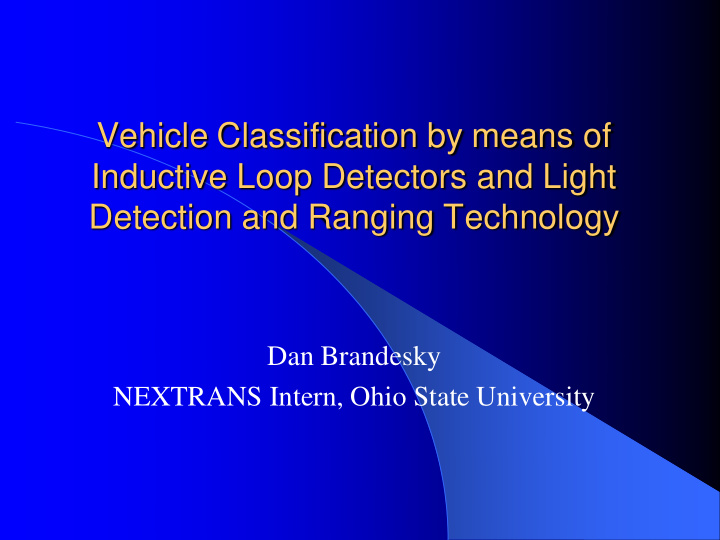



Vehicle Classification by means of Inductive Loop Detectors and Light Detection and Ranging Technology Dan Brandesky NEXTRANS Intern, Ohio State University
Internship Overview Internship focused on vehicle classification Use of new techniques applied to existing technologies – Precise vehicle classification through LIDAR imaging process – Length-based classification through use of freeway loop detector impulse data Internship only partially completed due to later start date (OSU still on quarter system)
LIDAR Overview LIDAR = Light Detection and Ranging Works on same principle as radar, but uses ultraviolet or infrared light – Shorter wavelengths of light provide much greater accuracy than radar LIDAR units can be used to produce a data “image” of an object Units scan in single axis (horizontal or vertical)
LIDAR Animation LIDAR unit contains a laser, reflected outward by a rotating mirror, shown in the top box Unit detects obstructions in the laser’s path, shown in the middle box Processed data is shown in the bottom box (converted from polar to Cartesian coordinates) Image Source: http://en.wikipedia.org/wiki/File:LIDAR-scanned-SICK-LMS-animation.gif
LIDAR-Equipped Van Honda Odyssey minivan outfitted with one front and one rear LIDAR unit, and two driver’s side LIDAR units – Front LIDAR scan horizontally, side LIDAR scan vertically Van also has one front and one rear camera, and a driver’s side view camera – Video data is then synchronized and cross-referenced with LIDAR data during processing to develop algorithms for vehicle classification
LIDAR-Equipped Van
LIDAR Research Currently working with MATLAB-based software tool to classify vehicular LIDAR detector data by category: •Cars •Buses •Small SUVs •Small/Large Single Unit Trucks •SUVs •Small/Large Dual Unit Trucks •Pickups •Motorcycles/Bicycles Use of LIDAR allows for more specific vehicle classification than normal FHWA “axle count” methods – Finer resolution of data – More accurate data for traffic surveys, etc.
LIDAR Data Collection Data is collected while van is being driven – Several pre-defined routes are used to give multiple data sets for single routes – As van is driven, differential GPS unit logs van’s location so that video and LIDAR data can be synced with a map of the route during processing At termination of a route, data is downloaded from the van computer and transferred to the campus server
LIDAR Data Processing MATLAB-based processing tool Two modes of operation: – Ground Truth Manually compare video and corresponding LIDAR data to determine if detected objects are indeed vehicles, or if they are other objects (e.g. pedestrians) – Vehicle Classification Manually re-process objects defined in earlier step as vehicles into more specific categories mentioned in previous slide
LIDAR Data Processing Ground Truth Mode
LIDAR Data Processing Vehicle Classification Mode
LIDAR Detection •Top image is stock photo of very similar vehicle to the one shown in the LIDAR image •LIDAR figure is clear enough to discern axles and vehicle’s windows, and height and depth Image Source: http://isuzu.sqserver.com/nprhd_vs_gm_c4500_16500.htm measurements (Y and Z axes, in meters) give even more information about detected vehicle •From LIDAR data alone, it is clear that this is not just a conventional pickup truck •Allows for more accurate data with fine resolution
Inductive Loop Detector Overview Inductive loops are wire loops buried in pavement, connected to an inductive loop detector in the controller cabinet Detector is “tuned” to normal inductance of loop, and when a vehicle passes over the loop, the loop inductance changes, and the detector sends and impulse to the controller Single loop detector stations (one per lane) are typically deployed on freeways for real time traffic monitoring
Inductive Loop Detectors in Vehicle Classification Currently, only dual-loop detector stations (meaning a station with two loops per lane, one after the other) are used for classifying vehicles and measuring speed Single loop detectors normally cannot classify vehicles because of differences in vehicle speeds and lengths – A long vehicle moving quickly could appear the same as a shorter vehicle moving slowly Developing the ability to use single loop detectors for vehicle classification is significant because there are many more single loops than dual loops, so it provides useful data from existing detectors – Less implementation cost to municipalities
Single-Loop Vehicle Classification Research Developing software algorithms for single loop detectors to classify vehicles by vehicle length Working to refine accuracy of algorithm – Began with simple categories: short, medium, and long Currently working with software tool to develop more specific categories by comparing loop detector impulse data from specific stations with video from adjacent traffic cameras – Measure vehicle length in pixels with software tool, which matches loop detector impulses with correct video frames Loop data is not always accurate due to various erroneous detections – Vehicles changing lanes cause impulses in two detectors by one vehicle – Incorrectly operating detectors may detect vehicles in adjacent lanes as well as their own lanes
Single-Loop Vehicle Classification Data Processing
Work In Progress Continue to process LIDAR data Work more with inductive loop vehicle classification Learn more about programming of MATLAB software tools Continue to collect data for analysis to improve precision of classification algorithms
Recommend
More recommend